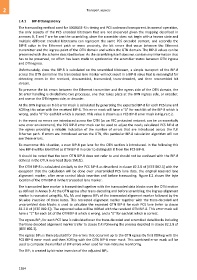Page 1274 - 5G Basics - Core Network Aspects
P. 1274
2 Transport aspects
E.4.1 BIP-8 transparency
The transcoding method used for 40GBASE-R is timing and PCS codeword transparent. In normal operation,
the only aspects of the PCS encoded bitstream that are not preserved given the mapping described in
annexes B, E and F are for one the scrambling, since the scrambler does not begin with a known state and
multiple different encoded bitstreams can represent the same PCS encoded content, and secondly the
BIP-8 value in the Ethernet path or more precisely, the bit errors that occur between the Ethernet
transmitter and the ingress point of the OTN domain and within the OTN domain. The BIP-8 values can be
preserved with the scheme described below. As the scrambling itself does not contain any information that
has to be preserved, no effort has been made to synchronize the scrambler states between OTN ingress
and OTN egress.
Unfortunately, since the BIP-8 is calculated on the scrambled bitstream, a simple transport of the BIP-8
across the OTN domain in the transcoded lane marker will not result in a BIP-8 value that is meaningful for
detecting errors in the received, descrambled, transcoded, trans-decoded, and then rescrambled bit
stream.
To preserve the bit errors between the Ethernet transmitter and the egress side of the OTN domain, the
bit-error handling is divided into two processes, one that takes place at the OTN ingress side, or encoder,
and one on the OTN egress side, or decoder.
At the OTN ingress an 8-bit error mask is calculated by generating the expected BIP-8 for each PCS lane and
XORing this value with the received BIP-8. This error mask will have a "1" for each bit of the BIP-8 which is
wrong, and a "0" for each bit which is correct. This value is shown as a PCS BIP-8 error mask in Figure E.2.
In the event no errors are introduced across the OTN (as an FEC protected network can be an essentially
zero error environment), the PCS BIP-8 error mask can be used to adjust the newly calculated PCS BIP-8 at
the egress providing a reliable indication of the number of errors that are introduced across the full
Ethernet path. If errors are introduced across the OTN, this particular BIP-8 calculation algorithm will not
see these errors.
To overcome this situation, a new BIP-8 per lane for the OTN section is introduced. In the following this
new BIP-8 will be identified as OTN BIP-8 in order to distinguish it from the PCS BIP-8.
It should be noted that the term OTN BIP-8 does not refer to and should not be confused with the BIP-8
defined in the OTUk overhead (byte SM[2]).
The OTN BIP-8 is calculated similarly to the PCS BIP-8 as described in clause 82.2.8 of [IEEE 802.3] with the
exception that the calculation will be done over unscrambled PCS lane data, the original received lane
alignment marker, after error control block insertion and before transcoding. Figure E.2 shows the byte
location of the OTN BIP-8 in the transcoded lane marker.
The transcoded lane marker is transmitted together with the transcoded data blocks over the OTN section
as defined in Annex B. At the OTN egress after trans-decoding and before scrambling, the ingress alignment
marker is recreated using M0, M1, M2 and ingress BIP3 of the transcoded alignment marker followed by the
bit-wise inversion of these bytes. This recreated alignment marker together with the trans-decoded and
unscrambled data blocks is used to calculate the expected OTN BIP-8 for each PCS lane (refer to clause
82.2.8 of [IEEE 802.3]). The expected value will be XORed with the received OTN BIP-8. This error mask will
have a "1" for each bit of the OTN BIP-8 which is wrong, and a "0" for each bit which is correct.
The egress BIP3 for each PCS lane is calculated over the trans-decoded and scrambled data blocks including
the trans-decoded alignment marker (refer to clause E.4) following the process depicted in clause 82.2.8 of
[IEEE 802.3].
The egress BIP3 is then adjusted for the errors that occurred up to the OTN egress by first XORing with the
PCS BIP-8 error mask and then XORing with the OTN BIP-8 error mask. This combined error mask will be
used to compute the number of BIP errors when used for non-intrusive monitoring.
The BIP7 is created by bit-wise inversion of the adjusted BIP3.
1264

